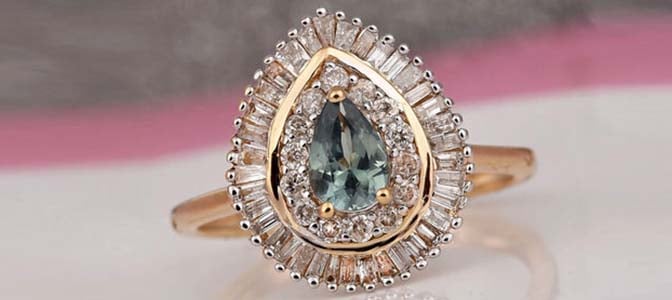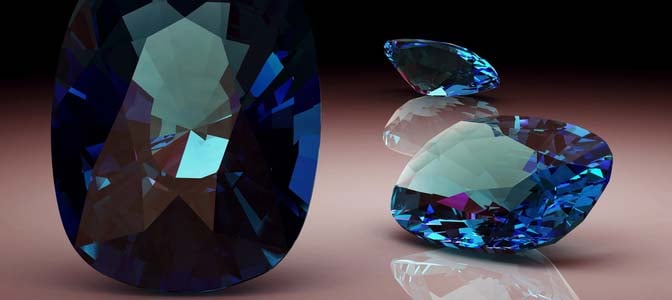
Introduction
Nature has given the gift of magic in its physical nature in the form of Alexandrite. It is green in sunlight and red in the night. Its colour- magic trick makes this gemstone unique. It is often regarded as the emerald by day, and ruby by night. It belongs to the chrysoberyl family. Alexandrite is so expensive and rare that only a few gemologists have got lucky to see its original version. It was named after Prince Alexander II of Russia as it was discovered on the day of his 18th birthday.
Often considered as Friday’s stone, or the stone of “Friday's Child,” this stone was first discovered in the 19th Century. In 1839, the stone got its name as Alexandrite as it appeared green or red. These colours were the old Imperial Russia’s military colours. It became the official national stone of tsarist Russia. It was one of the most prized gemstones amongst Russian Aristocracy.
New Arrivals in Alexandrite

Origin & Supply
Alexandrite was first discovered near the emerald mines close to Tokovaya River in Russia’s Ural Mountains. It is believed that all of Russia’s alexandrite was mined during the 19th Century. When everyone thought that this stone has got extinct, even larger deposits were found in Sri Lanka. After Sri Lanka, Brazil became another major contributor to this stone. Fine alexandrites have also been discovered in Myanmar, Tanzania, Madagascar, Zimbabwe, and India.

Facts About Alexandrite
- It exudes different colours in artificial and natural light.
- The rarest specimens of colour-change alexandrite have either yellow-green or plain green colour.
- Most large-scale alexandrite gemstones are found in antique Russian period pieces from the Victorian era.
- Largest known faceted alexandrite weighs 66-carat that is displayed at the Smithsonian Museum in Washington, DC
- This stone is extremely hard with 8.5 ratings on the Moh’s scale

Properties of Alexandrite
Alexandrite is a type of chyrsoberyl that displays a colour changing property under varying light conditions. It is deep grass green in daylight or fluorescent light, and vivid raspberry red during the night or incandescent light. Most valuable Alexandrite has a 100% colour shift from pure green to pure red. Blue-greens and purplish or brownish reds are of lesser value. Top-quality alexandrite is very rare and uncommon to be found in modern jewellery because it is hardly available and it is too expensive. Even lower quality stones are costly and very limited in supply.
- Colour: Alexandrite displays some of the most dramatic colour properties found in natural gems. An original alexandrite radiates the colour tones of both Emerald and Ruby in different lighting conditions. This gem comes with a strong pleochroism that means it displays different colours when viewed from different angles. It shifts its colour from emerald green to red and orange-yellow colours. It usually changes colour more dramatically in artificial light than in daylight. Colour change effect happens due to the strong absorption of light in the stone's yellow and blue portions.
- Cut: The colour-changing property of Alexandrite makes it a very challenging task to cut it. Its perfect cut is the one that displays a striking colour change through the crown. Other commonly available shapes are round, oval, triangle, and more.
- Clarity: You can find a different specimen of this stone with a different type of clarity they give. Alexandrite with higher clarity and the intense colour change is of greater value. Sometimes, you will find that this gemstone also has long and thin inclusions that create cat's eye phenomenon. This cat's eye phenomenon makes the stone more valuable.
- Carat: Alexandrite is such gemstone that is found in a petite size. Alexandrite worth five carats were traditionally found only in the Ural Mountains. Gems up to three carats are scarce. Price of this stone rises with the size of the gemstone.
FAQ's
Does Alexandrite go through any treatment?
Alexandrite gemstone does not usually undergo any treatment.
How to wear Alexandrite?
This stone with magical colour changing effect makes it a perfect stone to wear during the daytime event or an evening occasion. This stone works can be embellished to jewellery like rings, earrings, necklaces, pendants, and bracelets. It is also a popular choice for engagement rings because of its long-lasting nature, uniqueness, a magnificent play of colours, and rarity.
How to take care of Alexandrite?
Wash alexandrite jewellery in a solution of mild dish soap and lukewarm water. Using a soft brush to wipe off dust and fingerprints. You need to rinse it with fresh and cool water and dry with a soft and bubble-free cloth. You can also use ultrasonic and steam cleaners as they are usually safe for this gem. You must store this gem in a fabric-lined box or wrap it in a soft cloth.
Does Alexandrite scratch easily?
This stone ranks 8.5 on the Mohs scale of hardness. With an excellent toughness and no cleavage, this stone can be treasured for generations as it is stable under normal conditions.
Is Alexandrite a Birthstone?
Alexandrite is a birthstone for June, along with pearl and moonstone. Alexandrite is also considered to be the gem for the 55th wedding anniversary.
Is Alexandrite valuable?
Alexandrite is of higher price equivalent to gemstones like sapphires, rubies, emeralds, and diamonds, or even more than them. Alexandrite from Russia is of highest price if its origin is verified. It is rare to find alexandrite worth 0.25 cts. Superior quality alexandrite, above five or six carats, is extremely rare.
Again have similar chemical nature and behaviour as any Apatite. An Apatite as a gem is rare to find.



-in-Platinum-Over_7257348.jpg?w=464&h=464)
-in-Platinum-Over_7257348_1.jpg?w=464&h=464)


-in-Platinum-Overlay-Sterling-Silver-3.84_7180140.jpg?w=464&h=464)
-in-Platinum-Overlay-Sterling-Silver-3.84_7180140_1.jpg?w=464&h=464)
-in-Platinum-Overlay-Sterling-Silver-3._7170634.jpg?w=464&h=464)
-in-Platinum-Overlay-Sterling-Silver-3._7170634_1.jpg?w=464&h=464)